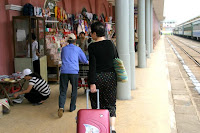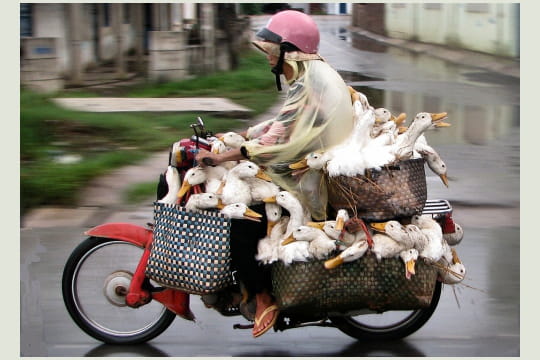the emptiness represents bombed areas for the most part
 Though everyone equates Hue with its imperial past, it is not only splendor and royalty that are recorded on these walls. During the Tet Offensive, a turning point in the War, the Viet Cong and North Vietnamese forces fought one of the longest and fiercest battles in this ancient capital city, killing masses of people and carrying out systematic executions in what was to be known as the "Massacre at Hue". If the walls could talk, I am sure they'd have stories to tell. Once you get past the gate, and away from the Palace, you begin to realize how immense this city was and is. Aside from the vast expanses of green grass and dirt roads are stand-alone walls that were once part of a building of sorts. The American War, as it is called here in VietNam, caused much of the damage, though hostilities prior to America's arrival had already left their mark here.Some of the walls still have their lovely archways, but all there is to see is grass on either side. At times, beyond the uncut grass, you'll catch a glimpse of part of the moat, its waters so still , except for the one nearest the entrance, which brims with life of koi fish.
Though everyone equates Hue with its imperial past, it is not only splendor and royalty that are recorded on these walls. During the Tet Offensive, a turning point in the War, the Viet Cong and North Vietnamese forces fought one of the longest and fiercest battles in this ancient capital city, killing masses of people and carrying out systematic executions in what was to be known as the "Massacre at Hue". If the walls could talk, I am sure they'd have stories to tell. Once you get past the gate, and away from the Palace, you begin to realize how immense this city was and is. Aside from the vast expanses of green grass and dirt roads are stand-alone walls that were once part of a building of sorts. The American War, as it is called here in VietNam, caused much of the damage, though hostilities prior to America's arrival had already left their mark here.Some of the walls still have their lovely archways, but all there is to see is grass on either side. At times, beyond the uncut grass, you'll catch a glimpse of part of the moat, its waters so still , except for the one nearest the entrance, which brims with life of koi fish.

I stared at the walls of this archway for a long time, as if waiting to hear something. It was still standing as if to tell me, I am here, but I have seen horrors; I have seen the inhumanity of man against man. And my old bones will remain so that I can tell those that will follow you and cross my path.
It was well after the war that mass graves had been discovered on these grounds, and the evidence showed that civilians had been tortured before being murdered. Some were thought to have been buried alive. Such carnage in an area that beheld so much splendor and majesty!
One of the buildings that appeared unscathed, but was closed to visitors, was the "Thai Binh" Reading Pavilion. It was surrounded by a beautiful garden, and someone was lovingly tending to it when we arrived at its entrance. It was built during the reign of Thieu Tri (1841-1847), and underwent restoration in 1921, and again, after the American War, in 1990 and 1991. The mosaics are superb and the style in great part Chinese. When I looked at the roofing, I was immediately reminded of similar roofs I had seen in Bankgok, at the Grand Palace. Far apart, yet bound by the same influence.
The Thai Binh Reading Pavilion
We walked around the building several times, peaking through the windows to try to catch a glimpse of what was inside. There were ladders and cords everywhere, and it was hard to see anything. The columns which support the structures are quite decorated colorful mosaic designs and Chinese characters. The Pavilion is the only building to have escaped destruction from the war.
This flower and rock garden lies directly in front of the main gate to the Pavilion
The workmanship of the roof is stunning
There was much more to see in Hue, but on a less than 48 hour stopover, we never saw the seven Imperial urns. It's a great excuse to come back.
if walls could talk





